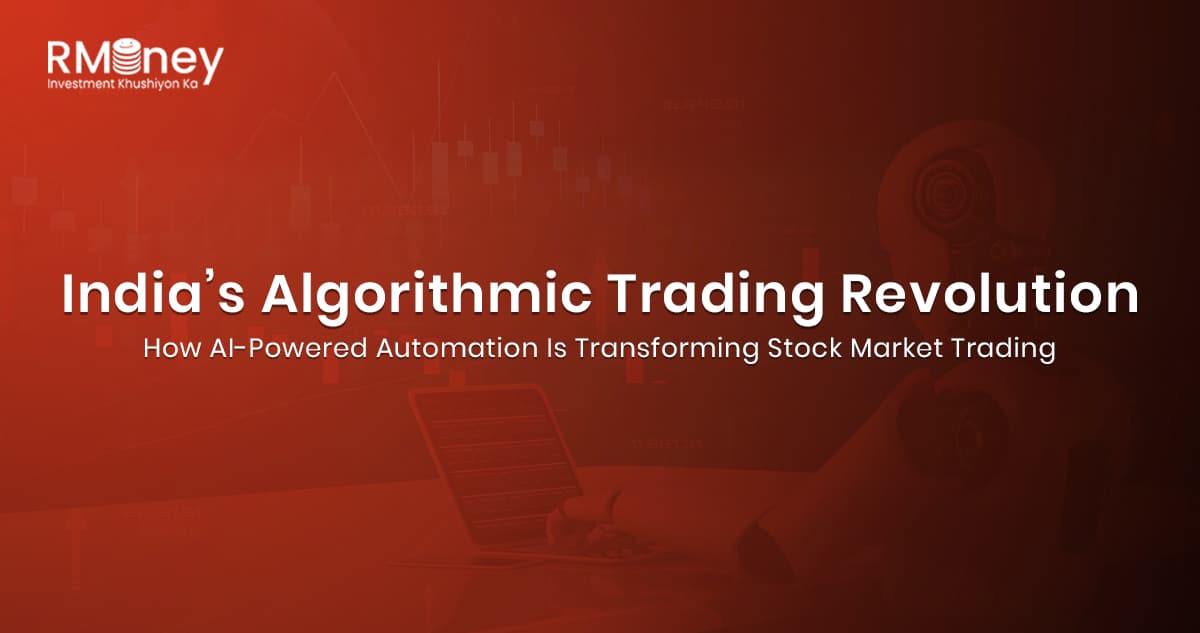India’s Algorithmic Trading Revolution: How AI-Powered Automation Is Transforming Stock Market Trading
Post Date : November 4, 2025

The Dawn of a New Trading Era in India
India’s financial markets are undergoing a massive transformation. What was once the dominated by manual trading is now being reshaped by algorithmic trading and automation bringing institutional-grade tools into the hands of more participants?
Recent data indicate that algorithmic systems have become a major part of trading activity, reflecting a shift not just in style, but in the very structure of how trades get executed. For example, algorithms accounted for approximately 57% of equity cash trades and ~70% of derivatives trades in recent data from Indian exchanges.
This isn’t simply a trend it’s a fundamental change in market mechanics, offering efficiency, speed, and accessibility like never before.
The Explosive Growth of India’s Algo-Trading Market
Market Size and Projections
India’s algorithmic trading market has witnessed unprecedented growth in recent years.
According to IMARC Group, the market reached USD 562.20 million in 2024 and is projected to soar to USD 1,274.48 million by 2033, registering a compound annual growth rate (CAGR) of approximately 9.5%.
Another study by Grand View Research presents a more aggressive forecast, estimating that India’s algorithmic trading market could reach USD 2,312.3 million by 2030, expanding at a CAGR of around 14.3%.
Whether you take the conservative or the aggressive estimate, the message is clear: the infrastructure, capital, and participation in algorithmic trading are scaling strongly in India.
Key Drivers of Growth
Several factors underpin this expansion:
- AI & Machine Learning Integration: Algorithms can now learn, adapt, and respond to changing market conditions faster than manual decision-making.
- Cloud Infrastructure Adoption: Affordable, scalable compute power reduces the barrier to entry for automated trading firms and individual traders.
- API / Platform Democratization: Retail-friendly platforms now provide access to algorithmic tools historically reserved for institutions.
- Regulatory Clarity: The regulator has introduced a structured framework for algorithmic trading, which increases confidence among participants and supports broader adoption.
Six Game-Changing Advantages of Algorithmic Trading
- Lightning-Fast Execution – Execution speed matters. Automated systems can place orders in milliseconds or microseconds, capturing fleeting opportunities such as arbitrage or thin-window price movements. For example, across multiple platforms, algorithms are now routinely doing what manual trading could never match in terms of timing.
- Emotion-Free Trading – Human traders are subject to fear, greed, and bias; algorithms are not. Once rules are programmed, trades execute strictly as per logic, reducing emotional errors like chasing losses, overtrading, or deviating from plan.
- Advanced Risk Management – Modern algorithms integrate protective mechanisms—dynamic position sizing based on volatility, adaptive stop-losses, trading limits at portfolio level, and real-time monitoring. These help guard against events like sudden market shocks.
- Easy Access – What used to be the exclusive domain of high-end trading firms is now increasingly accessible. Retail traders can engage with strategy-builders, plug-and-play algorithms, and cloud-based back-testing, and even marketplaces of pre-built systems— often requiring capital levels that are much lower than traditional institutional thresholds.
- Enhanced Market Liquidity– Automation brings continuous order flow, tighter bid-ask spreads, better execution quality and improved market efficiency. These improvements benefit the market ecosystem as a whole.
- Cost-Optimisation – Algorithms optimise trading costs through techniques like VWAP (volume weighted average price), smart-order routing, minimised slippage, and more efficient use of brokerage/leverage. Cost-savings directly bolster returns.
Regulatory Framework: Balancing Innovation and Protection
On February 4, 2025, the regulator introduced a circular titled “Safer Participation of Retail Investors in Algorithmic Trading”. This mandates that algorithmic strategies must be registered and approved by recognized exchanges, with brokers being accountable for client algorithms, and additional layers of security, transparency, and audit trail requirements.
Key elements include:
- Mandatory algorithm registration with the exchange.
- Broker oversight for algorithm deployment and monitoring.
- Security standards: two-factor authentication, static IP whitelisting for APIs, unique identification for each algorithm.
- Transparency: Clear disclosure of strategy risks, costs, and performance potential.
This framework gives participants the confidence to use automation while preserving market integrity.
What This Means for Indian Traders and Investors?
Opportunity Ahead
While algorithmic trading already commands a majority of activity in certain segments, many retail participants are still early in the adoption cycle. Those who equip themselves with understanding, discipline, and the right tools stand to benefit from this evolution.
Getting Started: A Practical Road-Map
- Education First: Learn the basics of algorithmic trading, strategy design, risk controls and market mechanics.
- Begin Small: Start with simple strategy logic and modest capital. Increase complexity and scale only after consistent performance.
- Choose the Right Platform: Ensure your broker or platform is compliant and offers access to quality data, back-testing, and algorithm deployment.
- Risk Management Must Come First: Never risk capital you cannot afford to lose. Use proper stop-losses, position sizing and give priority to capital preservation.
- Monitor & Adapt: Automation does not mean “set and forget.” Review strategy performance, market conditions and latency effects and keep refining.
The Road Ahead: India’s Algorithmic Future
Industry experts suggest India may achieve global-parity levels of algorithmic trading adoption within the next 5-7 years. Some trends to watch:
- Rising retail algorithmic participation (not just institutions).
- Increasing use of adaptive AI/ML systems in live trading.
- Evolving regulatory frameworks responsive to new risks like micro-latency, spoofing and manipulation.
- Improvements in infrastructure — lower latency, higher capacity, cross-market connectivity.
- Growth in cross-border algorithmic strategies as Indian markets open further to global participants.
Start Your Algorithmic Trading Journey Today
The future of trading is algorithmic – and the future is now. Whether you are a seasoned trader seeking automation or a newcomer eager to leverage systematic tools, algorithmic trading offers unprecedented opportunities.
Call us: 0562-4266600 / 0562-7188900
Email: askus@rmoneyindia.com
Get Started: Open your Demat Account today and take the first step towards smarter, control-driven trading.
Disclaimer: Algorithmic trading involves market risk. Past performance does not guarantee future results. This content is for educational purposes only and does not constitute investment advice. All trading strategies should be thoroughly back-tested and risk-managed before live deployment.

Stock Trading Now trade in ₹9 Per Order or ₹ 999 Per Month Plans.
Future & Options Access F&O contracts with advanced tools for hedging and speculation.
Currency Trading Trade in major currency pairs and manage forex exposure efficiently.
Commodity Trading Diversify Trading with MCX & NCDEX by Trading in Gold, Silver, Base Metals, Energy, and Agri Products.
Margin Trading Funding Boost your buying power with upto 5X, Buy now Pay Later
Algo Trading Back test, Paper Trade your logic & Automate your strategies with low-latency APIs.
Trading View Leverage Trading View charts and indicators integrated into your trading platform.
Advanced Options Trading Execute multi-leg option strategies with precision and insights.
Stock Lending & Borrowing Earn passive income by lending stocks securely through SLB.
Foreign Portfolio Investment Enable NRIs and FPIs to invest in Indian markets with ease and compliance.
IPO Invest in upcoming IPOs online with real-time tracking and instant allotment updates.
Direct Mutual Funds 0% Commissions by investing in more than +3500 Direct Mutual Fund Scheme.
Corporate FDRs Earn fixed returns with low-risk investments in high-rated corporate fixed deposits.
Stocks SIPs Build long-term wealth with systematic investment plans in top-performing stocks.
Bonds & NCDs Access secure, fixed-income investments through government and corporate bond offerings.
Depository Services Safely hold and manage your securities with seamless Demat and DP services with CDSL.
Journey Tracing our growth and milestones over time.
Mission & Vision Guided by purpose, driven by long-term vision.
Why RMoney Platform Smart, reliable platform for all investors' needs.
Management Experienced leadership driving strategic financial excellence.
Credentials Certified expertise with trusted industry recognition.
Press Release Latest company news, updates, and announcements.
Testimonials Real client stories sharing their success journeys.
7 Reasons to Invest Top benefits that make investing with us smart.
SEBI Registered Research Trusted insights backed by SEBI-compliant research.
Our Technology Advanced tools enabling efficient online trading.
Calculators Access a suite of smart tools to plan trades, margins, and returns effectively.
Margin Calculator Instantly check margin requirements for intraday and delivery trades.
MTF Calculator Calculate MTF funding cost upfront to ensure full transparency before placing a trade.
Brokerage Calculator Know your exact brokerage charges before placing any trade.
Market Place Explore curated investment products and trading tools in one convenient hub.
RMoney Gyan Enhance your market knowledge with expert blogs, videos, and tutorials.
Performance Tracker Track our research performance with full transparency using our performance tracker.
Feedback Share your suggestions or concerns to help us improve your experience.
Downloads Access important forms, software, and documents in one place.
Locate Us Find the nearest RMoney branch or service center quickly.
Escalation Matrix Resolve issues faster with our structured support escalation process.
Back Office Log in to view trade reports, ledger, and portfolio statements anytime.
Account Modification Update personal or bank details linked to your trading account.
Fund Transfer Transfer funds instantly online with quick limit updation to your trading account.
Bank Details View our registered bank account details for seamless transactions by NEFT, RTGS or IMPS.
How to Apply IPO Step-by-step guide to apply for IPOs using your trading account.
RMoney Quick Mobile App Trade on-the-go with our all-in-one mobile trading app.
RMoney Quick login Quickly access your trading account through the RMoney Quick web-based trading.
RMoney Rocket Web Version Experience powerful web-based trading with advanced tools for algo traders.
RMoney Rocket Mobile Version Trade anytime, anywhere with our feature-rich mobile trading platform.













